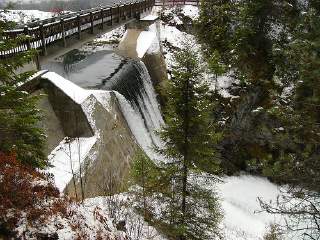SUMMARY
 A power company built 2 dams, power houses, diversion pipes, and transmission lines on Sullivan Creek in Northeast Washington almost a century ago. The project fell into disrepair in the 1950's and in 2007, project owner Pend Oreille PUD asked the Federal Energy Regulatory Commission (FERC) to give up jurisdiction over the project that could have allowed them to walk away from the facilities. This could have left the management of the dams in a regulatory no-man's land, creating a bad precedent that allows old dams to be abandoned. American Whitewater was the only public interest organization that intervened and protested, along with a local Tribe, the US Forest Service, and Washington State. FERC initially decided to give up jurisdiction, an action that would have left the dam and its fish passage, fish spawning, sediment transport, and recreation impacts in place. American Whitewater challenged this decision, and in March of 2008 we won with FERC reversing their earlier decision and requiring the owner to take responsibility and submit a surrender application.
A power company built 2 dams, power houses, diversion pipes, and transmission lines on Sullivan Creek in Northeast Washington almost a century ago. The project fell into disrepair in the 1950's and in 2007, project owner Pend Oreille PUD asked the Federal Energy Regulatory Commission (FERC) to give up jurisdiction over the project that could have allowed them to walk away from the facilities. This could have left the management of the dams in a regulatory no-man's land, creating a bad precedent that allows old dams to be abandoned. American Whitewater was the only public interest organization that intervened and protested, along with a local Tribe, the US Forest Service, and Washington State. FERC initially decided to give up jurisdiction, an action that would have left the dam and its fish passage, fish spawning, sediment transport, and recreation impacts in place. American Whitewater challenged this decision, and in March of 2008 we won with FERC reversing their earlier decision and requiring the owner to take responsibility and submit a surrender application.
This success launched two years of collaborative negotiations for how to surrender the license and decommission the project that led to a landmark Settlement Agreement in March of 2010. This agreement called for enhanced operation of Sullivan Dam that began in 2015 and provides downstream flow benefits, and complete removal of Mill Pond Dam (131 feet wide at the top and 50 feet high) that occurred in 2017. The agreement was integrated as part of the settlement for the nearby Boundary Hydroelectric Project operated by Seattle City Light, that provides the majority of Seattle's electricity. Seattle managed and funded the removal of Mill Pond Dam and restoration of Sullivan Creek as mitigation for the continued operation of their project. The project proved to be a novel approach of removing an outdated project, that a small local utility was ready to abandon, as a mitigation measure for the continued operation of a more valuable hydroelectric project representing a major regional electricity resource.
More information on the status of Sullivan Creek restoration can be found at the Mill Pond Dam and Habitat Restoration Project Website.
American Whitewater film Mill Pond Dam Removal Begins!
DETAILED HISTORY
Project Generates Power But Falls Into Disrepair
 The Sullivan Creek Project was constructed by the Inland Portland Cement Company in 1909, and was used to generate power until 1956, when the Project’s wood flume was damaged. The Project is located on Sullivan Lake, Outlet Creek and Sullivan Creek, a tributary of Washington's Pend Oreille River.
The Sullivan Creek Project was constructed by the Inland Portland Cement Company in 1909, and was used to generate power until 1956, when the Project’s wood flume was damaged. The Project is located on Sullivan Lake, Outlet Creek and Sullivan Creek, a tributary of Washington's Pend Oreille River.
Washington State’s water quality standards designate Sullivan Creek as a Class AA stream. Designated uses include fish migration, rearing, spawning and harvesting, wildlife habitat, water supply (domestic, industrial, agricultural), recreation (primary contact recreation, sport fishing, boating and aesthetic enjoyment), commerce, and navigation. State standards require that water quality of this class shall markedly and uniformly exceed the requirements for all or substantially all uses.” WAC 173-201A-030. The antidegradation policy requires that, “Existing beneficial uses shall be maintained and protected and no further degradation which would interfere with or become injurious to existing beneficial uses shall be allowed.”
The Project occupies lands of the United States within the Colville National Forest. The Project, as originally constructed, consisted of Sullivan Lake Dam and Reservoir, Sullivan Creek diversion dam and conduit, and Mill Pond Dam and reservoir, conduit, penstock, power plant, and transmission facilities. See Public Utility District No. 1 of Pend Oreille County, Washington, 20 F.P.C. 753, 754 (1958).
The Licensee purchased the Project and its associated water rights from Inland in 1959, and has operated the project reservoirs to benefit hydroelectric generation at downstream projects and for water supply to the town of Metaline Falls. The Federal Power Commission (“FPC”) issued a 50-year license for the Project effective October 1, 1958. See id. The FPC licensed the Project as a storage project benefiting the downstream generation projects, with provisions for the Licensee to study the feasibility of enlarging or rehabilitating the Project for purposes of power generation.
Prior to accepting the license, the Licensee requested that the FPC modify the license so that it did not describe certain of the project works as abandoned, thus requiring a Forest Service permit for the occupancy of National Forest lands by these project works. See Public Utility District No. 1 of Pend Oreille County, Washington, 21 F.P.C. 284 (1959). The Licensee stated that the project works had not been abandoned and requested that the diversion dam and conduit and the flume section of the power conduit from Mill Pond be included in the license as project works. See id. The project boundary was modified to include the lands occupied by the discontinued project works, thus eliminating the need for a Forest Service permit. See id. at p. 285.
Over the course of the existing license, the Licensee twice filed license amendments proposing changes to allow for power generation. Licensee withdrew its 1994 application for license amendment in 2002.
Pend Oreille PUD Decides They No Longer Want the Project
On September 23, 2003, the Licensee filed a notice of intent not to file an application for a new license for the Project. On October 22, 2003, the Commission published notice of the licensee’s intent, and required that any applications for a new license for the Project must be filed by September 30, 2006. No applications were filed.
On October 5, 2006, Licensee filed a Petition for Declaratory Order (“Petition”) requesting the Commission to determine that the existing license for the Sullivan Creek Project (P-2225) is void. See e-Library no. 20061005-5016 (Oct. 5, 2006). In the alternative, the Licensee requested a determination that the license will expire on October 1, 2008, with no further action required by the Commission or the Licensee.
On November 20, 2006, American Whitewater filed a timely, unopposed Motion to Intervene and Protest (“AW Protest”) in response to the Petition. See e-Library no. 20061121-5081. The U.S. Department of Agriculture, through the U.S. Forest Service (“Forest Service”), also filed a timely, unopposed Notice of Intervention and Protest (“Forest Service Protest”) in response to the Petition. See e-Library no. 20061117-5106 (Nov. 17, 2006).
On July 18, 2007, the Director of the Division of Hydropower Administration and Compliance (“Director”) issued the instant Order. The Director declined to declare the existing license void. However, he found that the Project is not required to be relicensed upon expiration of the existing license in 2008: “The current license will expire by its own terms with no further Commission action on October 1, 2008.” Order, Ordering ¶ A.
On August 17th, 2007, American Whitewater, with the superb help of the Natural Heritage Institute, filed a Request for Rehearing with the FERC. This filing asked FERC to reconsider their decision, based on significant legal grounds, and asked that the FERC require settlement talks to discuss project removal and/or transfer of jurisdiction to the Forest Service. The US Forest Service and Washington State also filed similar requests for rehearing.
On March 20th, 2008 FERC partially granted and partially rejected our rehearing request. They agreed that the project must be licensed, and therefore that the licensee had to immediately initiate a license surrender proceeding. They further ordered that the Licensee had to secure a special use permit from the USFS for any remaining project works. Paradoxically they decided that once part of the project was removed (Millpond Dam, the flume, and the powerhouse), the remaining parts would no longer require FERC oversight (Sullivan Dam). This is logical and legal hole that you could drive a raft through. Regardless, the result for Sullivan Creek has been positive.
Developing and Implementing the Agreement for Dam Removal
With the legal matters behind us, the parties began meeting monthly to reach a collaborative solution that met all legal, ecological, recreational, and economic interests.
On March 29th, 2010, a Settlement Agreement was filed by all parties calling for the removal of Mill Pond Dam and enhanced operation of Sullivan Dam.
The settlement agreement was accepted by FERC and several years of detailed planning commenced. American Whitewater advocated for the restoration of the historic channel beneath the reservoir, and an excellent team of engineers and partners developed the removal plan.
Dam removal commenced in September of 2017 and was completed by the end of the year!
